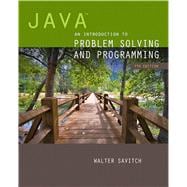Note: You are purchasing a standalone product; MyProgrammingLab does not come packaged with this content. If you would like to purchase both the physical text and MyProgrammingLab search for ISBN-10: 0133862119/ISBN-13: 9780133862119. That package includes ISBN-10: 0133766268/ISBN-13: 9780133766264 and ISBN-10: 0133841030 /ISBN-13: 9780133841039.
MyProgrammingLab is not a self-paced technology and should only be purchased when required by an instructor.
Java: An Introduction to Problem Solving and Programming, 7e, is ideal for introductory Computer Science courses using Java, and other introductory programming courses in departments of Computer Science, Computer Engineering, CIS, MIS, IT, and Business. It also serves as a useful Java fundamentals reference for programmers.
Students are introduced to object-oriented programming and important concepts such as design, testing and debugging, programming style, interfaces inheritance, and exception handling. The Java coverage is a concise, accessible introduction that covers key language features. Objects are covered thoroughly and early in the text, with an emphasis on application programs over applets.
MyProgrammingLab for Java is a total learning package. MyProgrammingLab is an online homework, tutorial, and assessment program that truly engages students in learning. It helps students better prepare for class, quizzes, and exams–resulting in better performance in the course–and provides educators a dynamic set of tools for gauging individual and class progress.
Teaching and Learning Experience
This program presents a better teaching and learning experience—for you and your students.
- Personalized Learning with MyProgrammingLab: Through the power of practice and immediate personalized feedback, MyProgrammingLab helps students fully grasp the logic, semantics, and syntax of programming.
- A Concise, Accessible Introduction to Java: Key Java language features are covered in an accessible manner that resonates with introductory programmers.
- Tried-and-true Pedagogy: Numerous case studies, programming examples, and programming tips are used to help teach problem-solving and programming techniques.
- Flexible Coverage that Fits your Course: Flexibility charts and optional graphics sections allow instructors to order chapters and sections based on their course needs.
- Instructor and Student Resources that Enhance Learning: Resources are available to expand on the topics presented in the text.








